Menus
- Light, nimble, reliable
- Static clumsiness gives way to lively handiness
- BMW Boxer tilts to the right when accelerating
- The chassis can be operated with the throttle "to adjust"
- Short final translation, successful trail inserts
- Technical data Schek replica
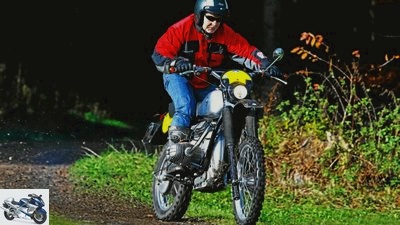
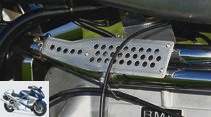
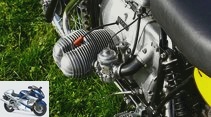
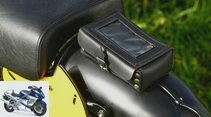
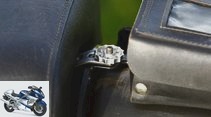
25th photos
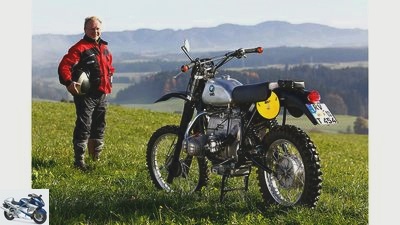
fact / Joachim Schahl
1/25
Werner Koch about the shek replica:
Are such replicas even allowed to appear in a classic magazine? But of course, because the builders strictly, if not consistently, used contemporary components. In addition, it would be a shame to over-restore the original motorcycles in this quality. There is nothing more beautiful and honest than off-road machines with the clay crust of the Sixdays of 1973 or the last difficult Swabian off-road drive.
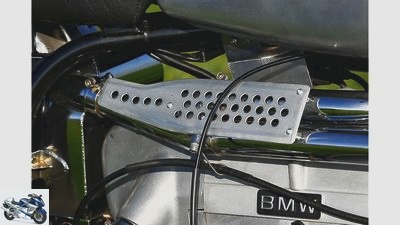
fact / Joachim Schahl
2/25
Effective heat shield at the manifold junction.

fact / Joachim Schahl
3/25

fact / Joachim Schahl
4/25
Hand-sewn leather bag and …
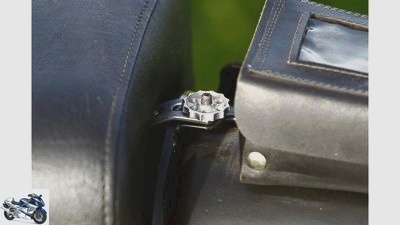
fact / Joachim Schahl
5/25
… an M6 knurled nut as a work of art.

fact / Joachim Schahl
6/25
Nicely hidden and protected from falling, the silencer takes the place of the battery.
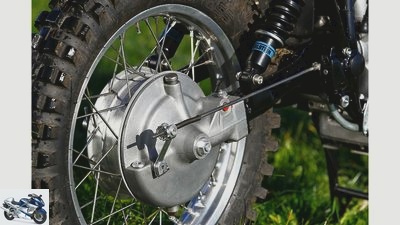
fact / Joachim Schahl
7/25
Twisted brake hub, thru axle made of high-strength aluminum, lightened clamping screw.
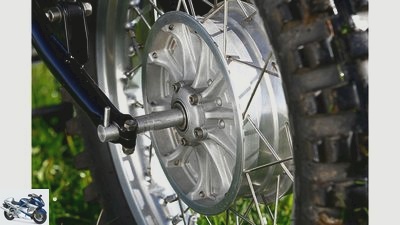
fact / Joachim Schahl
8/25
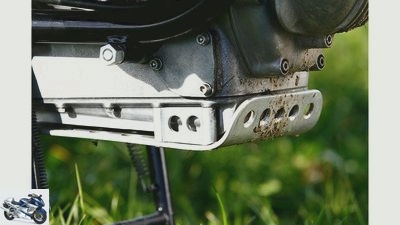
fact / Joachim Schahl
9/25
Aluminum plate as oil pan protection with solid support to the engine housing.
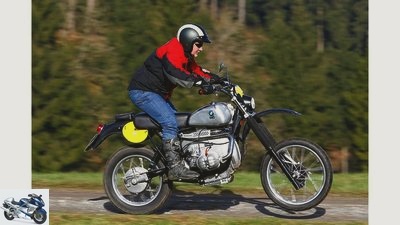
fact / Joachim Schahl
10/25
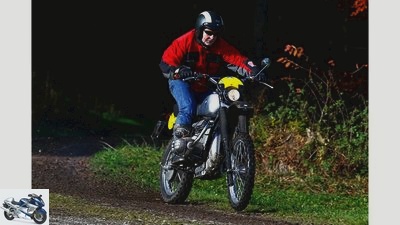
fact / Joachim Schahl
11/25
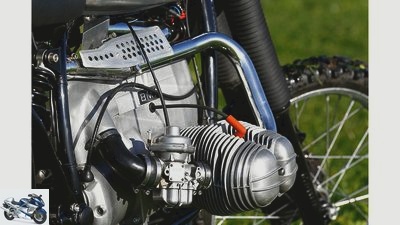
fact / Joachim Schahl
12/25
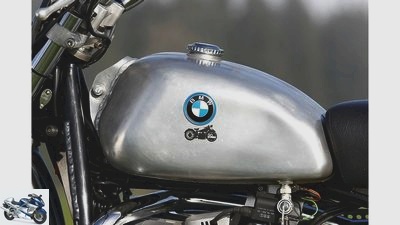
fact / Joachim Schahl
13/25
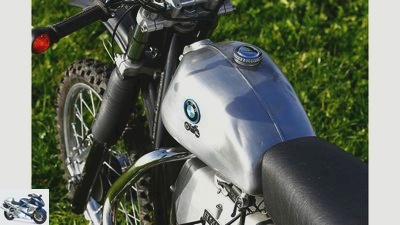
fact / Joachim Schahl
14/25
Short Maico aluminum tank with BMW propeller.

fact / Joachim Schahl
15/25
Spring travel of around 250 millimeters, …

fact / Joachim Schahl
16/25
… the short maico tank and …
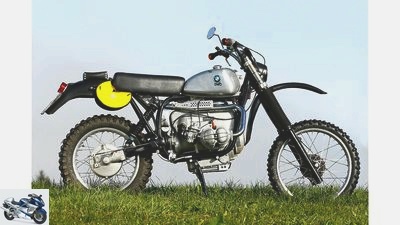
fact / Joachim Schahl
17/25
… Coarse-tread cross tires shape the image of the off-road sport BMW.
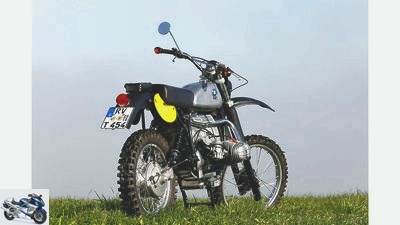
fact / Joachim Schahl
18/25
The replica is powered by an air-cooled two-cylinder four-stroke boxer engine with a displacement of 980 cm³.

fact / Joachim Schahl
19/25
This gives it around 60 hp at 6500 rpm.
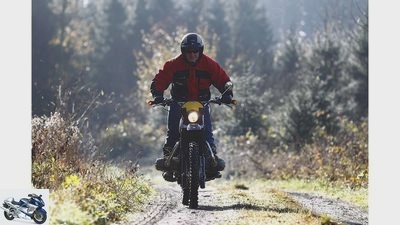
fact / Joachim Schahl
20/25
So the 165 kg dry weight can be moved very quickly through the undergrowth.
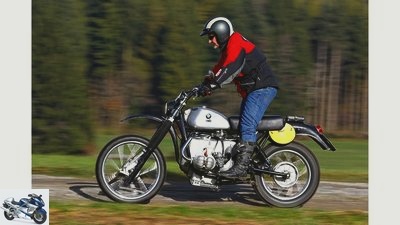
fact / Joachim Schahl
21/25
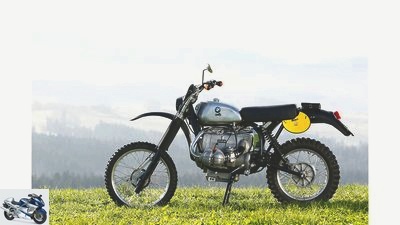
fact / Joachim Schahl
22/25
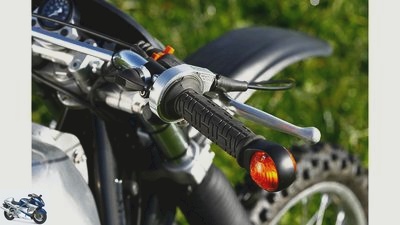
fact / Joachim Schahl
23/25
Perfect metal craft down to the last detail. Indeed …
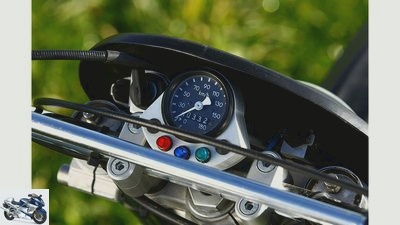
fact / Joachim Schahl
24/25
… Such milled parts were rare in the 1970s.
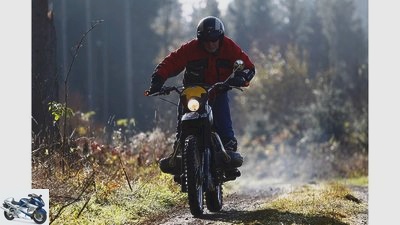
fact / Joachim Schahl
25/25
On the move with the Schek BMW replica
Light, nimble, reliable
Content of
Off-road drives were and are pure drag, which is why Herbert Schek tailored his own BMW for the ride through the undergrowth: light, nimble, reliable. We found a replica of the Shek GS from the 1970s.
W.How crazy did you actually have to be to take part in the big, ruthless cross-country sport events of the 1960s and 1970s in a boxer BMW? Six-day trips in the pouring rain, during which a nimble 125cc Zundapp bored into the mud up to the tank cap. Steep ascents that ended with the slightest throttle in a somersault backwards. Ruts milled so deep that the motorcycle disappeared into them all the way to the tank. And that on a three-centimeter chunk in which the cylinders spread over three-quarters of a meter across the direction of travel. Was this necessary? Yes, it had to be. Because it was precisely this apparent contradiction that drove the Munich-based company to prove to the world that their concept is also equipped for such demanding undertakings.
Buy complete article
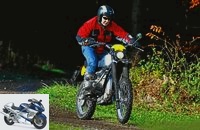
On the move with the Schek BMW replica
Light, nimble, reliable
Herbert Gletter’s shek replica
Up until now, the off-road missions were more the playground of the BMW sports department, but things got serious at the end of the 1970s. Now the successes of the big enduros should accompany the market launch of the R 80 G / S. Exactly 17 so-called Schek-BMWs were built by the tall factory driver in Wangen im Allgau. Back then with two suspension struts and based on the / 5 engines, today these models are often copied.
When we were looking for one, we struck gold again at Herbert Gletter. That boxer specialist in Ratzenried, right in the middle of the epicenter of the cross-country sport stronghold between Wangen and Isny in the Allgau. Gletter, himself in possession of an original Schek BMW and significantly involved in the conversion, made contact with Hugo Schollhorn, who made his beautiful replica available to us for a test ride through the Allgau around Isny. In this way: thank you very much. And should a complaint about driving on forest paths flutter into the house – just forward it.
Static clumsiness gives way to lively handiness
Thanks to the electric starter – lightweight construction fetishists save around five kilograms of “special equipment” – the 980 boxer grumbles at the first ignition. If the cross-country athlete with the mighty high bench on the main stand still makes an almost indomitable impression while standing, the long-legged boxer sinks gently and far into the suspension when saddling up. With a tight steering angle, maneuvering and turning require some effort and good balance. Once in motion, the static clumsiness gives way to a lively, easy handling. As if made for this, knees and thighs nestle perfectly against the tiny Maico tank, and steed and rider merge into a harmonious unit. If you disregard the rough rolling of the coarse motocross tires on the 21-inch front wheel, the Schek replica gives a very full, safe impression from the first meter. The raised handlebars with the classic Magura fittings are ideally at hand and provide a confident overview of the game. The only thing you shouldn’t rely on is the Maico half-hub brake. The simplex construction in combination with the pointed motocross studs on asphalt cannot elicit more than a subtle delay. Well, this type of motorcycle has no place on firm ground.
So let’s go to Wallachia. When gravel roads get lost deep and deep in the forest and solid ground gives way to boggy forest floor with plenty of irrigated ruts, it’s not just the off-road sports tunnels that are a reliable number. The engine is also top notch. The flat twin accelerates as smoothly as butter and pushes the 165 kilogram replica through the muddy ground with an incredible amount of traction. Despite the high wheel load on the rear wheel, there is nothing to complain about about the stability. With the boxer firmly on the knees but with a loose grip on the handlebars, he follows every steering impulse without hesitation. Crossing ruts at an acute angle, flying over waves and holes with a pull on the rear wheel – the GS replica is unwaveringly looking for the right path.
BMW Boxer tilts to the right when accelerating
The extremely soft spring / damper setting fits perfectly with the soft, rounded driving style. The three hundredweight can be perfectly concealed with a lot of swing and fluid choice of lines instead of tough, quick-witted style. Nevertheless, it is surprising how easily the terrain monster makes the U-turn even in the narrow 180-degree bend on the front wheel. However, in such dances, the inside leg must be raised far above the cylinder and used more as a balancing weight than as a support function.
But that’s not all, after all, a BMW reveals other things that need getting used to – and not just off-road. As soon as the front wheel takes off, the Schek replica lapses into a vehement right-hand twist, which must be corrected with a consistent shift in weight. The reason for this phenomenon is the direction of rotation of the longitudinal crankshaft. Briefly explained for non-BMW drivers: A BMW boxer tips over to the right with a short jerk when accelerating. If this so-called reverse torque acts at the moment when the front wheel is not in contact with the ground, the whole motorcycle tips over to the right. In many boxer machines, this permanent right-hand twist is often even noticeable through asymmetrical wear on the front wheel!
The chassis can be operated with the throttle "to adjust"
And of course there is also the swing reaction, better known under the term “elevator effect”. Due to the torque of the cardan shaft and in combination with the long-stroke, softly tuned suspension struts, the rear rises as if by magic when you accelerate. If you take off the gas, the motorcycle collapses in front and back almost synchronously. What is difficult to regulate for the off-road racing driver without BMW experience opens up the possibility for shrewd boxer warriors to make use of precisely these chassis reactions. With deep, rough bumps or hard edges, the rear wheel suspension is literally hardened with a full engine thrust. The suspension, which is too soft in itself, resists bottoming out. The other way around, when braking into curves, it becomes a shoe because the braking torque of the motor pulls the rocker upwards. Result: The motorcycle remains relatively “flat” and stable even on braking shafts. Conventional motocross and off-road machines often “stand” too much on the front wheel during such maneuvers and wildly wedge left and right with their hindquarters. Handlebar bumps when braking are also often the result of steep steering geometry or poorly responding telescopic fork.
In this regard, Hugo Schollhorn opted for the Maico fork, which was adapted to the higher weight with harder springs and revised innards, which was probably the best solution at the time. Nevertheless, it takes a good deal of experience and effort to get the BMW chassis into position at the right moment with the right throttle. And the driving situation does not always allow the chassis to be stabilized. Which means that the off-road BMW has to be moved through the underbrush with foresighted tactics. The weight of 165 kilos alone forbids getting the load stuck in the thicket.
Short final translation, successful trail inserts
The engine has the least effort to drag horse and rider out of the mud. Almost everything remained as standard on the R 75/6 engine, which was “drilled out” to 980 cubic centimeters. No lightened centrifugal masses, no borderline compression, no sharp camshafts. That is probably why the ohv boxer acts more like a tractor than a racehorse. With a solid, stable idling and without the risk of the engine stopping abruptly on low-revving trails, you can do without the dry clutch, which is left as standard. The short final translation is enough to find the right gear for every situation. Whereby the gear stages change their position surprisingly precisely and without gear shift for BMW conditions. But anyone who knows Herbert Gletter knows that a standard gearbox does not have to remain standard in his projects. His penchant for perfection simply calls for the finishing touches to every relevant component. All of which means that everything works a little more precisely and more easily. Herbert Gletter and Hugo Schollhorn have not abandoned this perfection in this Schek replica, even in detail. Solid footrests screwed to the frame or the manually milled MMB speedometer console with indicator lights are just as much a part of it as playful, feather-light aluminum knurled nuts or the multi-part, ingeniously housed silencer.
The rear wheel hub, which is as light as possible, with the aluminum thru-axle also shows that this Schek replica is not only due to its function. Here someone has given free rein to his pronounced mechanical play instinct, which is only possible if the project is not subject to time pressure.
In contrast to the 70s, when the self-made off-road machines primarily had to function reliably and were driven through dust and mud every weekend, this project, which began in 2010, was allowed to mature for a good year and a half until it was road legal.
Technical data Schek replica




25th photos
Pictures: On the move with the Schek BMW replica
To home page
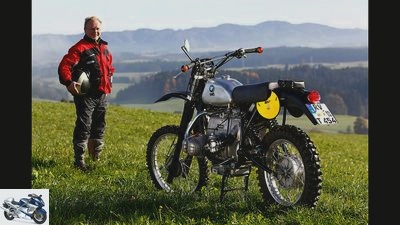
fact / Joachim Schahl
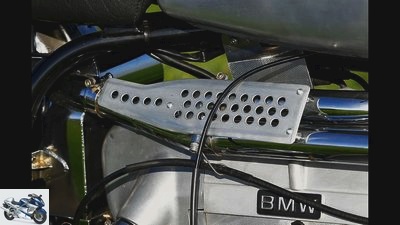
fact / Joachim Schahl
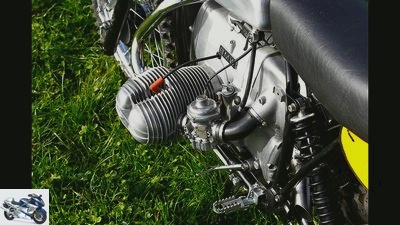
fact / Joachim Schahl
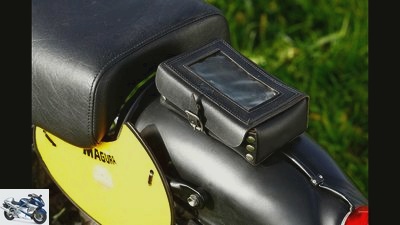
fact / Joachim Schahl
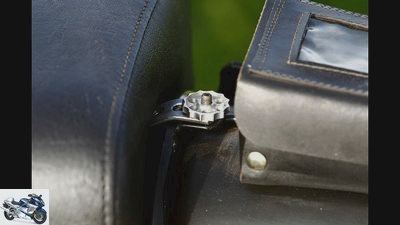
fact / Joachim Schahl
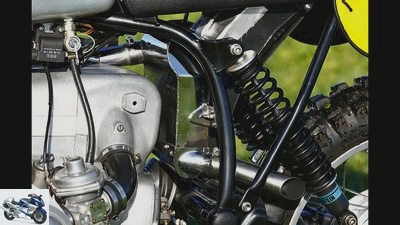
fact / Joachim Schahl
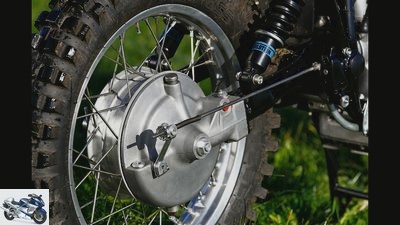
fact / Joachim Schahl
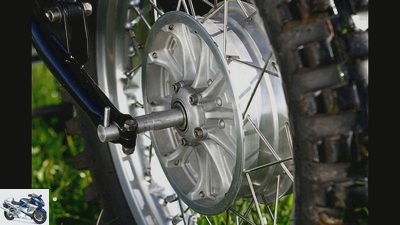
fact / Joachim Schahl

fact / Joachim Schahl
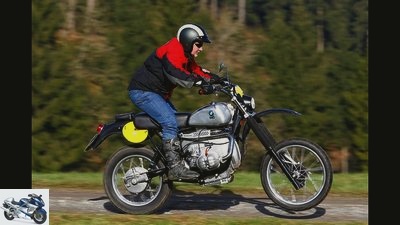
fact / Joachim Schahl
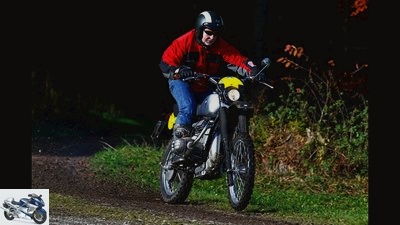
fact / Joachim Schahl

fact / Joachim Schahl

fact / Joachim Schahl

fact / Joachim Schahl

fact / Joachim Schahl
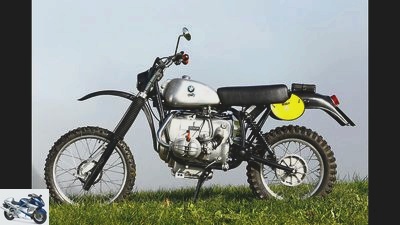
fact / Joachim Schahl
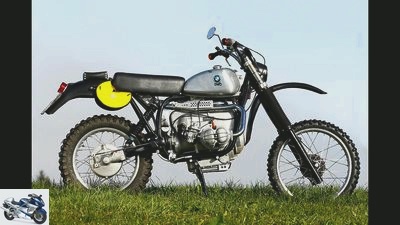
fact / Joachim Schahl
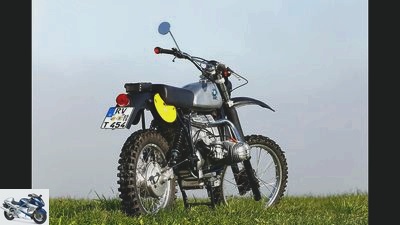
fact / Joachim Schahl
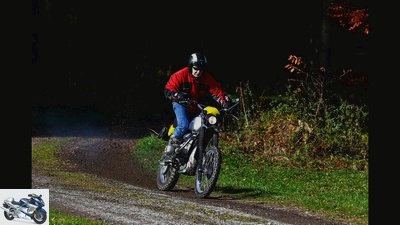
fact / Joachim Schahl
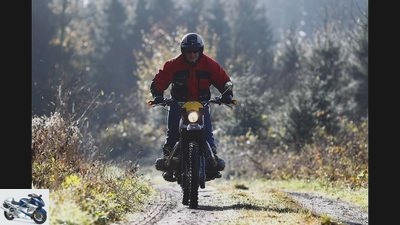
fact / Joachim Schahl
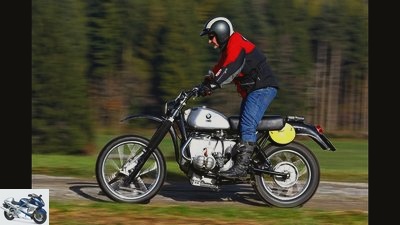
fact / Joachim Schahl
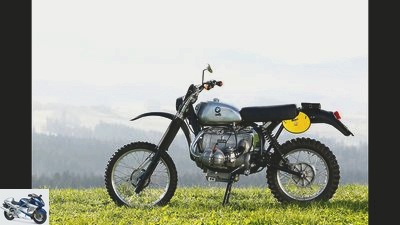
fact / Joachim Schahl
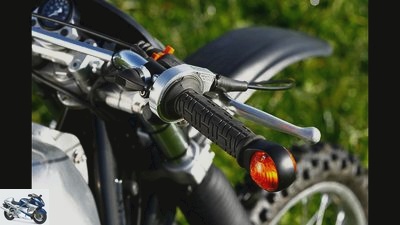
fact / Joachim Schahl
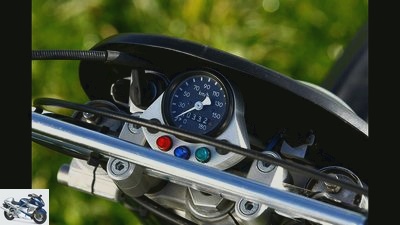
fact / Joachim Schahl
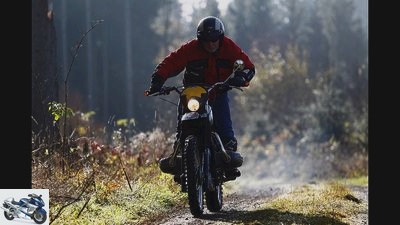
fact / Joachim Schahl
Related articles
-
Ducati MHR 1000 Mike Hailwood Replica
Archive 19 pictures fact / Joachim Schahl 1/19 A real gem in the wild: The Ducati MHR 1000. fact / Joachim Schahl 2/19 Ducati MHR 1000 ….
-
Scene: Hildebrand & Wolfmuller replica
Bilski scene: Hildebrand Wolfmuller replica The first to the second content by Hildebrand Wolfmuller are considered the first motorcycles to be built in series …
-
Yamaha RD 500 LC: Grand Prix replica with V4 two-stroke engine
fact 10 pictures archive 1/10 As elaborately as the engine and chassis were achieved, the cockpit was drawn so simply. Archive 2/10 The 16-inch device makes bends …
-
Driving report Aprilia mille R Edwards replica
Driving report Aprilia mille R Edwards replica In Colin’s footsteps Haga had one, Bostrom had one, and now the reigning Superbike world champion has …
-
Norton Manx F-Type replica in the studio
Bilski 17 pictures Bilski 1/17 One of the few photos that served as a template for the Norton Manx F-Type replica. Bilski 2/17 The “Norton-Franz” …
-
Oxley 19 pictures Oxley 1/19 Giampiero Sacchi’s lifelong dream was always to rebuild the legendary Gilera four-cylinder racing machine, with which Libero Liberati …
-
Jorg Kunstle comparison test two-cylinder: BMW R 1100 S Boxer-Cup-Replika, Buell Firebolt XB9R, Ducati SS 1000 DS, Moto Guzzi V11 Le Mans Rosso Corsa Feel …
-
MHR 1000 by Gerold Vogel – small series based on the Mike Hailwood replica
Photo: fact 28 pictures fact 1/28 fact 2/28 fact 3/28 fact 4/28 fact 5/28 fact 6/28 fact 7/28 fact 8/28 fact 9/28 fact 10/28 fact 11/28 fact 12/28 fact …
-
In the studio: Honda CR 750 Daytona replica
Sdun Honda CR 750 Daytona replica motorcycle classic: Ready to Race Contents of She is crouched in the studio, she is willing to be photographed. The Honda CR …
-
Accessories for the BMW R nineT Racer: Road replica conversion kit from Wilbers
Topic special Everything about BMW Motorrad fact. 6 pictures fact. 1/6 The conversion kit from Wilbers is intended to make the R nineT Racer more suitable for everyday use. fact. 2/6 …